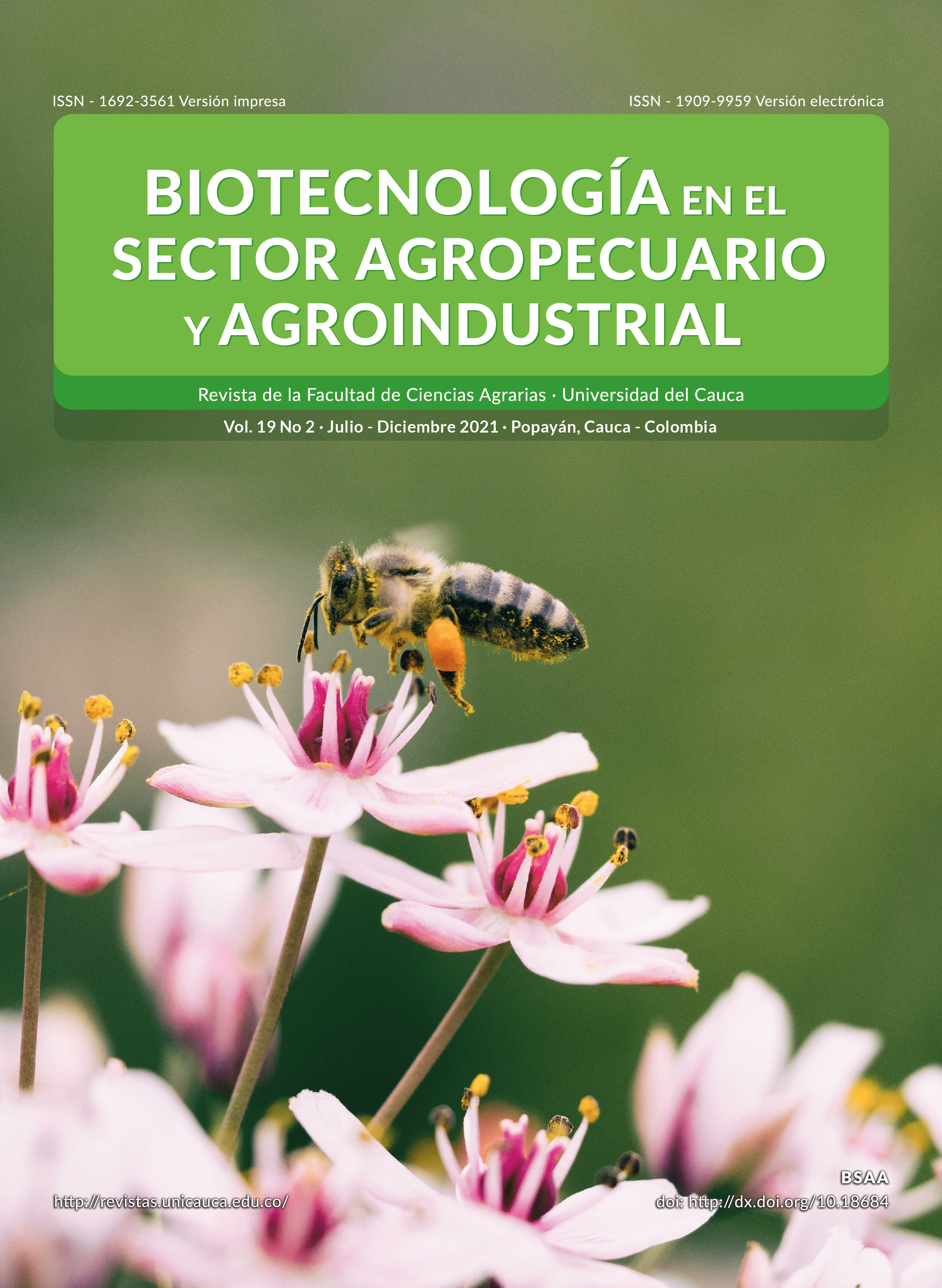Ácido fítico en papa nativa Solanum tuberosum L. determinado por 31P RMN
Resumen
La escasa información publicada acerca de la significancia del ácido fítico en nutrición y salud humana hace necesario iniciar un estudio para identificarlo y cuantificarlo en la papa, que es el cuarto alimento más consumido a nivel mundial y es ingrediente importante de las papillas que ingieren los bebes desde los 4 meses de edad. El objetivo de la presente investigación fue identificar y cuantificar el ácido fítico en papa nativa Huagalina de la Región La Libertad, cultivada con abono orgánico y compararlo con el contenido en papa comercial. Para la extracción de fitato, se utilizó NaOH - EDTA y el análisis de los compuestos se realizó mediante RMN 31 P. En estos espectros además de las señales del 31P del ácido fítico se observaron la del fosfato a 5.50 ppm y la del glicerol fosfato a 4.42 ppm. Dado que estos desplazamientos químicos coinciden con lo reportado en la literatura, se emplearon las áreas debajo de estas señales para cuantificar su presencia en los distintos extractos de papa abordados. En particular, resalta el alto contenido de ácido fítico de la pulpa de la papa comercial (0.078 %) comparada con el de la pulpa de Huagalina (0.035 %).
Descargas
Asuntos:
papa nativa andinaDisciplinas:
Resonancia Magnética NuclearLenguajes:
EspañolReferencias bibliográficas
CALLIOPE, SONIA-ROSARIO; LOBO, MANUEL- ÓSCAR; SAMANN, NORMA-CRISTINA. Biodiversity of Andean potatoes: Morphological, nutritional and functional characterization. Food Chemistry, v. 238, n. 1, 2018, p. 42-50.https://doi.org/10.1016/j.foodchem.2016.12.074
COLBY, VORLAND; STREMKE, ELIZABETH; MOORTHI, RANJANI; HILL, KATHLEEN. Effects of excessive dietary phosphorus intake in bone health. Current Osteoporos Reports, v. 15, n. 5, 2017, p. 473-482.https://dx.doi.org/10.1007%2Fs11914-017-0398-4
DAHDOUH, SERGIO; GRANDE, FERNANDA; ESPINOSA, SANDRA-NAJERA; VINCENT, ANNA; GIBSON, ROSALIND; BAILEY, KARL; KING, JANET; RITTENSCHOBER, DORIS; CHARRONDIERE, U. RUTH. Development of the FAO/INFOODS/IZINCG Global Food Composition Database for Phytate. Journal of Food Composition and Analysis, v. 78, 2019, p. 42-48. https://doi.org/10.1016/j.jfca.2019.01.023
DONG, QIN; ECHIGO, KOHEI; RABOY, VICTOR; SANEOKA, HIROFUMI. Seedling, growth, physiological characteristics, nitrogen fixation and root nodule phytase and phosphatase activity of a low-phytate soybean line. Plant physiology and Biochemistry, v. 149, 2020, p. 225-232. https://doi.org/10.1016/j.plaphy.2020.02.015
EL-AZEIM, ABD; SHERIF, M.A.; HUSSIEN, M.S.; TANTAWY, I.A.; BASHANDY, S.O. Impacts of nano-and non nanofertilizers on potato quality. Acta Ecologica Sinica, v. 40, n. 5, 2020, p. 388-397.https://doi.org/10.1016/j.chnaes.2019.12.007
FEKRI, AREZOO; TORBATI, MOHAMMADALI; KHOSROWSHAHI, AHMAD; BAGHERPOUR, HASAN; AZADMARD-DAMIRICHI, SODEIF. Functional effects of phytate- degrading, probiotic lactic acid bacteria and yeast strain isolated from Iranian traditional sourdough on the technological and nutritional properties of whole wheat bread. Food Chemistry, v. 306, 2020, p. 125620. https://doi.org/10.1016/J.FOODCHEM.2019.125620
GRADOS, D.; GARCIA, S.; SCHREVENS, E. Asessing the potato yield gap in the Peruvian Central Andes. Agricultural Systems, v. 181, 2020.https://doi.org/10.1016/j.agsy.2020.102817
GUTIERREZ, ORLANDO M.; PORTER, ANNA K.; VIGGESWARAPU, MANJULA; ROBERTS JOSEPH L.; BECK Jr., GEORGE R. Effects of phosphorus and calcium to phosphorus consumption ratio on mineral metabolism and cardiometabolic health. The Journal of Nutritional Biochemistry, v. 80, 2020, p. 108374.https://doi.org/10.1016/j.jnutbio.2020.108374
INGELMANN, C.; WITZING, M.; MOHRING, J.; SCHOLLENBERGER, M.; KUHN, I.; RODEHUTSCORD, M. Phytate degradation and phosphorus digestibility in broilers and turkeys fed different corn sources with or without adding phytase. Poultry Science, v. 98, n. 2, 2019, p. 912-922.https://doi.org/10.3382/ps/pey438
KAHSAY, WORKAT-SEBNIE. Effects of nitrogen and phosphorus on potatoes production in Ethiopia: A review. Cogent Food & Agriculture, v. 5, 2019, p. 1-7. https://doi.org/10.1080/23311932.2019.1572985
KUNATSA, YVONNE; CHIDEWE, CATHRINE; ZVIDZAI, CUTHBERT. Phytochemical and antinutrient composite from selected marginalizes Zimbabwean edible insects and vegetables. Journal of Agriculture and Food Research, v. 2, 2020. 100027.https://doi.org/10.1016/j.jafr.2020.100027
NURMANOV, YERBOL; CHERNENOK, VALENTINA; KUZDANOVA, ROZA. Potato in response to nutrition regime and nitrogen fertilization. Field Crops Research, v. 231, n. 1, 2019, p. 115-121. https://doi.org/10.1016/j.fcr.2018.11.014
OGHGHO, VICTOR; SANTORO, ANNA; THOSS, VERA. Characterization of plant seeds by Phosphorus-31 Nuclear Magnetic Resonance Spectroscopy. Analytical Letters, v. 50 n. 6, 2017, p. 999-1012.https://doi.org/10.1080/00032719.2016.1206910
PHILLIPPY, BRIAN; LIN, MENGSHI; RASCO, BARBARA. Analysis of phytate in raw and cooked potatoes. Journal of Food Composition and Analysis, v. 17, 2004, p. 217-226.https://doi.org/10.1016/j.jfca.2003.08.001
RABOY, VICTOR. Low phytic acid Crops: Observations based on four decades of research. Plants, v. 9, n. 2, 2020, p. 140.https://doi.org/10.3390/plants9020140
RAVOY, VICTOR; GIBSON, ROSALIND; BAILEY, KARL; KING, JANET. Comparison of four methods for phytate analysis in plant-based foods. Journal of Food Composition and Analysis, v. 90, 2020, p. 103481.https://doi.org/10.1016/j.jfca.2020.103481
SANTOS, CARLA; CUNHA, SARA; CASAL, SUSANA. Bioactive Components in Potatoes as Influenced by Thermal Processing, Processing and Impact on Active Components in Food. In book : Processing and Impact on Active components in food, 2015, p.111-119.https://doi.org/10.1016/B978-0-12-404699-3.00014-7
SCHELEMMER, ULRICH; FROLICH, WENCHE; PRIETO, RAFAEL; GRASES, FELIX. Review: Phytate in foods and significance for humans: Food sources, intake, processing, bioavailability, protective role and analysis. Molecular Nutrition & Food Research, v. 53, 2009, p. S330-S375. https://doi.org/10.1002/mnfr.200900099
SORATO, ROGERIO; SANDAÑA, PATRICIO; FERNANDES, ADALTON; MARTINS, JESSICA; JOB, ANDRÉ. Testing critical dilution cropped in tropical Oxisols of southeastern Brazil. European Journal of Agronomy, v. 115, 2020, p. 126020. https://doi.org/10.1016/j.eja.2020.126020
UDOUSORO, I.I.; UDO, E.S.; UDOH, A.P.; UDOANYA, E.E. Proximate and antinutrients compositions, and health risk assessment of toxic metals in some edible vegetables, Nigerian. Journal of Chemical Research, v. 23, n. 2, 2018, p. 51–62.https://www.ajol.info/index.php/njcr/article/view/181933
VAZ DE MELO, PRISCILA; AMARO, PATRICIA; MIRANDA, HELEN-HERMANA; ARAUJO, CAROLINA; MINARDI, ROSANGELA; SILVA GOMES, JULIANA; DE OLIVEIRA, ALINE-APARECIDA; DE OLIVEIRA, CARLA. Dietary non-nutrients in the prevention of non-communicable disease: Potentially related mechanics. Nutrition, v. 66, 2019, p. 22-28.
https://www.sciencedirect.com/science/article/abs/pii/S0899900719300474?via%3Dihub
WOLTERS, M.; DIEPENMAAT, H.; HERMUS, R.; VORAGEN, A. Relation between In vitro availability of minerals and food composition: A mathematical model. Journal of Food Science, v. 58, n. 6, 1993, p.1349-1355.https://doi.org/10.1111/j.1365-2621.1993.tb06181.x


 Español
Español Inglés
Inglés





















.png)



